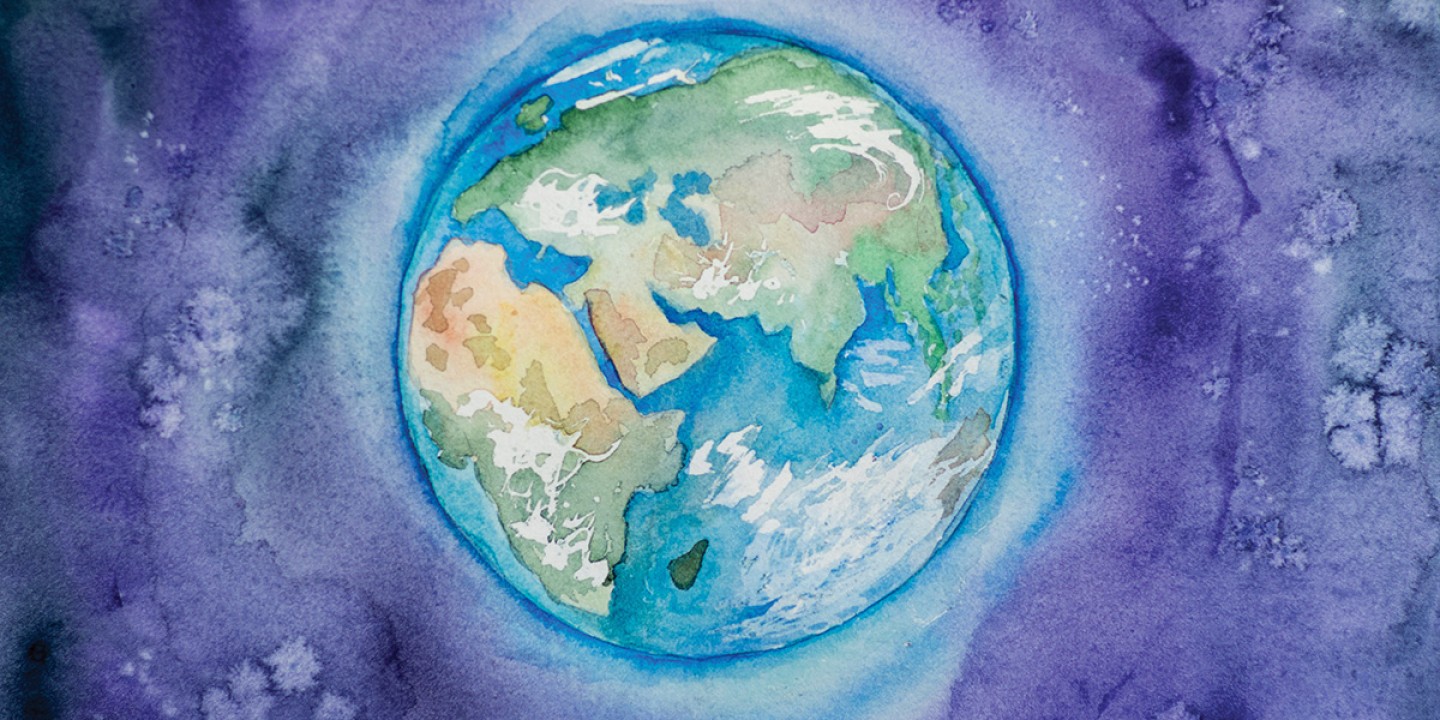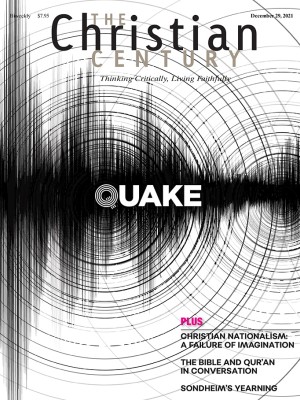How should I pray for the climate?
I followed COP26 from a distance. Other Christians showed up in Glasgow and asked God to intervene.

Two years ago, I was reading an issue of Geez magazine on climate justice in my room at night when the heaviness of the climate crisis flooded me. In my evangelical days I was what some called a “prayer warrior,” but on this night the best response I could muster was to walk out the back door and crumple into an apology once my feet touched the grass. I felt a physical need to make contact with the earth, not indirectly through the floorboards, but with my skin.
Wordless embodied acts have largely constituted my prayer life in recent years. I grew weary of asking God to intervene in large and small crises, and such prayer came to feel performative. Tending the garden and listening to birdsong in a forest preserve now often feel like the only genuine prayer I can offer for a chronically ill planet.
Read our latest issue or browse back issues.
But this fall, as preparations for the United Nations climate summit in Glasgow (COP26) got underway, I became intrigued by the number of faith groups, including evangelicals, mobilizing to influence the proceedings. Here were some Christians asking God to show up supernaturally in international climate negotiations while also planning to show up themselves on the conference grounds. Could I learn something from them?
A few days before COP26, I meet on Zoom with Lowell Bliss, founder of Climate Intercessors. The Christian group has been convening monthly since the summit was postponed in 2020 to pray and “stand in the gap” caused by the delay. Bliss is set to board a plane to Glasgow right after our conversation.
A climate activist since 2009, Bliss has joined many faith-based vigils, declarations, and prayer breakfasts for the climate, but he admits that he hasn’t felt the power of prayer the way he remembers from his time as a missionary in India. “What’s the difference?” I ask.
“It’s the asking,” he replies. “The expectation of some sort of answer whereby you could revise your prayer and come back again.” This kind of prayer revision, he continues, comes from the Desert Fathers’ idea of diakrisis, or discernment. “There’s got to be some openness to receiving back an answer.”
I think back to the tacky GAP (God Answers Prayers) T-shirts I wore in my fervent years as a new Christian in the Bible Belt. I have my reasons for no longer sporting such sayings, but right now—when we’re facing reasonable predictions of worldwide ecosystem collapse—seems like a good moment to revisit the claim they make.
The next morning I get up early and look out the window to maple boughs dancing in the remnants of an autumn storm. “God,” I start out, talking into the slowly brightening morning air. The act of address takes the breath out of my spiritual lungs, so I take a moment to collect myself. Maybe it’s a name problem, I think, because no presence tunes in when I say “God”—a word so smothered by abstraction and systematic theology that whoever it refers to has no space left to inhabit.
I try again. “Creator . . .” After a few minutes I sputter, “COP26 . . . emissions . . . please . . .” By the time I utter about five barely coherent words the baby has woken up in the room across the hall and sounded his vocal alarm to start my morning.
“God is a real character and an effective agent in the world,” Bliss says in a Climate Intercessors video and again in our conversation. He is echoing Walter Brueggemann, who writes in The Prophetic Imagination that this claim “is surely an embarrassment to many religious progressives.” It’s a claim, Lowell admits, that is certainly open to question in the Anthropocene and at COP26.
I follow the summit proceedings from a distance and check in with contacts on the ground. Some celebrate landmark events like a global methane pact and more countries committing to phase out coal and end deforestation. Meanwhile, Greta Thunberg tweets, “This is a Global North greenwash festival. A two week celebration of business as usual and blah blah blah.” I whiplash between hope and despair, and I wonder if there is really such a clear distinction between the two. Maybe it is healthy, I think, to feel everything rather than present the world a one-dimensional facade of Christian hope.
In a webinar, UN climate action leader Selwin Hart notes that some countries’ 2030 emissions reduction goals are not in line with their own net-zero timelines—they’re relying on technology that has yet to be developed. Hart describes their actions as “reckless and irresponsible.” I’m tempted to pray imprecatory psalms over these politicians and their fossil fuel lobbyists. Just deserts for putting political expediency and profit over responsible action. But I can’t escape my own complicity, living comfortably in one of these countries off the unjustly hoarded fat of the land.
Friends (including Bliss) in the Christian Climate Observers Program have passes to the blue zone of negotiations as civil society delegates. They gather each morning for prayer at St. George’s Tron in Glasgow, and I join various prayer meetings virtually. “Does it matter?” I ask them. “Do the prayers change anything?”
Bliss points out that I am bringing up an old debate that played out in these very pages. As science was on the ascent in the late 19th century, John Tyndall, known as the “father of climate science,” kicked off what is now known as the prayer-gauge debate: he attempted to subject prayer to the rigors of the scientific method. In the decades that followed, Christians who wanted to maintain intellectual credibility entertained questions of whether shipwrecked voyages had fewer missionaries onboard praying, or whether praying for certain hospital wards would result in different patient outcomes.
Rick Ostrander captures the nuances of the debate in his book The Life of Prayer in a World of Science. He describes a Century symposium on the efficacy of prayer in which James M. Gray, Harry Emerson Fosdick, and others weighed in (“Does prayer change the weather?” September 10, 1930). Gray cites historical examples of answered prayer, while Fosdick calls prayers for rain “crude, obsolete supernaturalism.”
Ostrander suggests that by this time the liberal Protestant understanding of prayer “was virtually indistinguishable from that of its secular counterpart, religious humanism.” Prayer, in this view, mainly benefits the ones praying, putting them in touch with inner spiritual resources and aligning them with the purposes of the universe. However, Ostrander writes, they perceive “no ‘friend behind the phenomena.’”
This divide—between prayer that calls a personal God to one’s aid and prayer as therapy—is what Bliss and his colleagues long to bridge. “I’m convinced that climate is an issue where those two streams can merge again,” says Bliss. “We can pray that God will empower us to do right and justly. We can pray that he himself will intervene. It doesn’t have to be deus ex machina. Who are we to limit what God wants to do or not do, even miraculously?”
I find myself teetering between these views on any given day. Sometimes praying for divine intervention feels like an abdication of responsibility. I sympathize with Derrick Jensen’s words in Orion magazine: “When we stop hoping for external assistance . . . then we are finally free—truly free—to honestly start working to resolve it. I would say that when hope dies, action begins.” If Jensen is right, praying for the climate might not be simply irrelevant, but harmful. It shifts the agency from humans to God, the supposed adult in the room, and then turns humans into misbehaving and unhelpful children, from whom little is expected.
But when I pray about the climate, this is the exact thing I cannot let go of: the nagging sense that there could be someone else in the room. That we may yet somehow connect with this someone who is different enough from us humans that something new could emerge from the interaction.
Perhaps I’m longing not just for the company of God but for the community of all creation—for relief from what Robin Wall Kimmerer calls “species loneliness.” I wonder if we short-circuit our communion—and our access to spiritual power—by going straight to creation’s God. This short-circuiting—this refusal to see our relatedness with the rest of the natural world and instead elevating ourselves to a higher plane—is what got us into this mess in the first place.
Maybe my impulse to go out, physically touch the earth, and repent is not so off base. The First Nations Version of the New Testament renders Matthew 7:7 like this: “Let your prayers rise like smoke to the Great Spirit, for he will see and answer you. Every step is a prayer, and as you dance upon the earth for the things you seek, the way will open before you.”
For the disastrously changing climate, I still don’t know how or what to pray. But dance upon the earth—that I can do. I can lean on the rough, ridged bark of the maple tree outside my front door. When I feel a bit sturdier myself, I don’t discount that a spiritual transaction has taken place. That new possibilities have opened up.
Likewise, when I call on the tree’s creator as a force to be reckoned with here in my yard—and maybe, even, at COP26—I’m admitting an actor beyond humanity into the picture. The center of energy shifts, and I’m no longer alone in the room. The air around me feels a little less stagnant. I fill my lungs with air and then exhale.
A version of this article appears in the print edition under the title “Climate intervention.”





